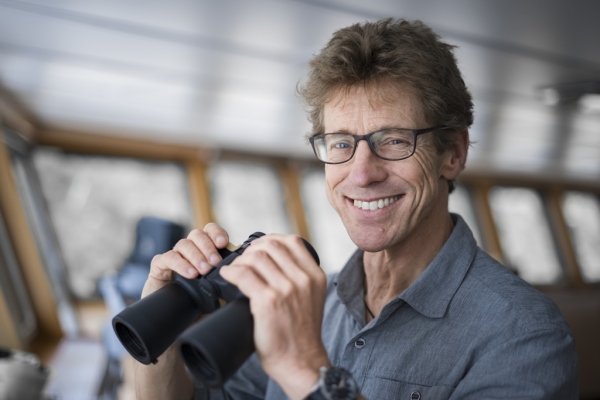Forty intrepid adventurers leave Wellington next week for a six-week scientific voyage to Antarctica.
Research voyages to Antarctica are undertaken by NIWA once every two years and take place in one of the most extreme environments on the planet.
NIWA’s flagship research vessel Tangaroa leaves port on Thursday, February 8, and will take about seven days to reach the Ross Sea shelf break east of Cape Adare, about 3400 km south of Wellington, for the first large-scale experiment of the voyage. This is Tangaroa’s 12th Antarctic voyage.
Voyage leader and NIWA marine ecologist Dr David Bowden says the science research programme involves several disciplines and fitting in all the work that needs to be done will require both careful planning and luck.
“Voyage planning is a juggling act that needs a very efficient crystal ball. We want to squeeze in as much science as possible but we know before we even get to Antarctica that the weather, ice conditions, and sea state will affect us at some point.”
The research aims of the voyage are to better understand:
- Climate change effects on oceanographic processes
- Marine microbial community structure and function
- Influence of marine aerosols on cloud formation and properties of Antarctic clouds
- Seabed habitats and fauna inside and outside of the Ross Sea Marine Protected Area (MPA)
- The role of whales in the Antarctic ecosystem
- Abundance and distribution of mesopelagic fish found between 200 and 100m deep, krill, and zooplankton
One of the key outcomes of the research will be to generate baseline data required to determine whether the objectives of the MPA are being achieved. The MPA covers more than 1.55 million square kilometres and came into existence in December.
The ship will carry 23 scientists and 17 crew. Together their work ranges from taking atmospheric and oceanographic observations and samples, to whale spotting, maintaining the vessel, and cooking meals around the clock to service the 24-hour operation of the ship.
Tangaroa is currently undertaking a fisheries survey on the Chatham Rise and is not due back in port until Monday, leaving just a couple of days to load specialist equipment and provisions needed for the voyage.
NIWA’s general manager of vessels operations Greg Foothead says Tangaroa has been through a series of checks and maintenance to ensure it is ship shape. Antarctic survival gear and provisions will be on board, additional space heaters have been installed and ice matting will be laid on the decks to prevent slips. All crew have undertaken survival training and rigorous medical checks to ensure they are fit for this remote voyage.
“We are also taking an extra work boat for the whale research and fitting a lot of new equipment on the ship for the atmospheric studies.”
The Tangaroa master is Evan Solly, a recognised ice navigator who has been aboard the ship for all but one of its 12 Antarctic voyages. He is able to navigate the vessel through the sea ice, although this voyage will not be going as far south as previous voyages.
“We’re not expecting the ice to be too much of an issue but we have contingency plans in place if the route has to change,” Mr Foothead says.
He says the greatest challenge for people will be to remember the Antarctic environment is not very forgiving of mistakes and that they need to take extra care.
“For instance, people working outside could be exposed to hypothermia or frostbite if not adequately prepared. If they experience numbness or are feeling drowsy it’s a sign they need to get inside and warm up. We try to mitigate most of the potential hazards but people need to be more vigilant than normal.”
Dr Bowden says the research on this voyage is important on several levels. Improved understanding of physical oceanographic processes and ocean-atmosphere interactions in the Southern Ocean will contribute to refining the earth system models that allow us to understand, predict, and plan for future change.
“These physical processes, in turn, are fundamental to ecosystem functioning in the region. By studying physical and biological processes in parallel, we can develop a more complete understanding of the Ross Sea regional marine ecosystem. This is important in the context of the new Ross Sea MPA because our data will contribute to establishing a baseline for the status of the MPA at the time of its initiation.”
The voyage is a joint expedition between NIWA and the University of Auckland, with additional funding from MBIE, the Deep South National Science Challenge and the New Zealand Antarctic Research Institute and collaboration with the Korea Polar Research Institute and Australia Antarctic Division.
Antarctic voyage facts
- Tangaroa will travel about 7800km on the six-week voyage
- The 70m-long ship is ice-strengthened but is not an ice breaker
- This is Tangaroa’s 12th Antarctic voyage
- There will be 23 science staff and 17 crew aboard
- The ship operates around the clock with two 12-hour shifts.
- Supplies on board include 400kg potatoes, 100kg onions, 30kg kiwifruit, 30kg of bacon, 20 legs of lamb and 28kg coffee.
- A full tank of diesel costs more than $500,000 and will take the ship to Antarctica and back several times over.

